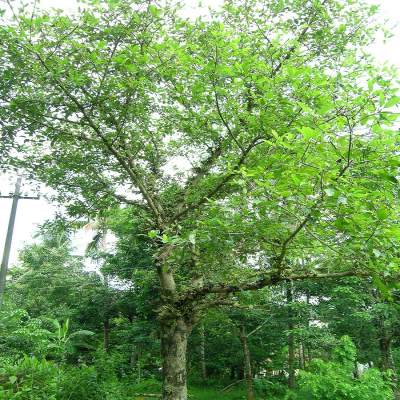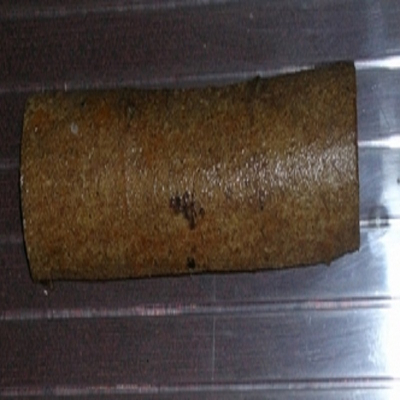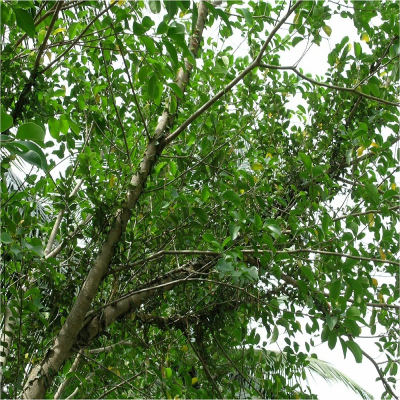Ficus racemosa Linn.
Synonyms : F. glomerata Roxb.
Family : Moraceae
Group : 5. Nalpamaram, 6. Star trees
Parts Used : Bark
Vernacular Names :-
| English | : | Cluster fig, Gular fig |
| Malayalam | : | Atthi |
| Hindi | : | Gular umar |
| Sanskrit | : | Udumbarah |
| Bengali | : | Jagga dumur |
| Gujarathi | : | Umar |
| Kannada | : | Atti |
| Tamil | : | Atti |
| Telungu | : | Udambaramu |
Distribution and Habitat: Ever green tree; it is distributed all over India.
Botany: It is a moderate to large-sized spreading laticiferous, deciduous tree without many prominent aerial roots.
- Leaf: Leaves are dark green and ovate or elliptic.
- Fruit: Fruit receptacles are 2-5 cm in diameter, sub-globose or pyriform arranged in large clusters on short leafless branches arising from main trunk or large branches. Figs are smooth or rarely covered with minute soft hairs. When ripe, they are orange, dull reddish or dark crimson. They have a pleasant smell resembling that of cedar apples.
- Bark: The bark is rusty brown with a fairly smooth and soft surface, the thickness varying from 0.5-2 cm according to the age of the trunk or bark. Surface is with minute separating flakes of white tissue. Texture is homogeneously leathery.
- Inflorescence: A syconia borne on short leafless branches or warty tubercles of trunk or on larger branches. Flowers unisexual. Male flowers near the mouth of receptacles, in 2-3 rings, sessile, much compressed; female flowers sessile or very shortly stalked among gall flowers; gall flowers long stalked. Flowering starts from December to January.
- Seeds : Numerous, tiny seeds, 1500 -1600 seeds per fruit.
Properties:
- Leaf is antibilious
- Stem- bark is hypoglycaemic and anti-protozoal.
- Gall is CVS active.
- Root is antidysenteric and antidiabetic.
- Latex is antidiarrhoeal.
- Bark and syconium is astringent
Chemical constituents: Stem-bark gives glauanol acetate, b-sitosterol, leucocyanidin-3-O-b-D-glucopyrancoside, leucopelargonidin -3-O-a-L-rhamnopyranoside, lupeol, ceryl behenate, lupeol acetate and a-amyrin acetate
Uses:
- Powdered leaves mixed with honey are given in vitiated condition of pitta. A decoction of the leaves is a good wash for wounds and ulcers.
- Tender fruits (figs) are used in vitiated conditions of pitta, diarrhoea, dyspepsia and haemorrhages. The ripe fruits are sweet, cooling and are used in haemoptysis, thirst and vomiting.
- Roots are useful in treating dysentery.
- Stem bark is an ingredient of ‘Nalpamara’. Bark is tonic and used in rinder pest diseases of cattle. It is useful as a wash for wounds, highly efficacious in threatened abortions and recommended in uropathy.
- The latex is administered in haemorrhoids piles, and diarrhoea.
Agro technology:
Propagation:
- Propagation mainly through seeds. Seeds germinate 10-15 days after sowing. Seed requirement per acre is 0.5 g. Seeds stay viable up to 6 months. Plant 7-8 months old seedlings in field.
- The plant is vegetatively propagated by stem cuttings and air layering. Stem cuttings of pencil thickness taken from the branches are to be kept for rooting. Rooted cuttings are to be transplanted at 2-2.5 months age to prepared pits.
- Air layering is also practiced in the month of August to September. Layering in branches of old trees registered 80 - 90% rooting.
Seed treatment : Soak seeds in hot water at 65̊C for 10 minutes and sow in fine medium like leaf compost, composted coirpith etc.
Spacing : 5 m x 5 m
No. of plants per acre : 160 nos.
Irrigation: Irrigation is not a must as the plant is hardy.
Harvesting: Bark can be collected after 15 years. Ficus species generally has an economic life span of more than hundred years. Hence bark can be regularly collected from the tree. Root, bark, leaves, fruits and latex form the economic parts.




